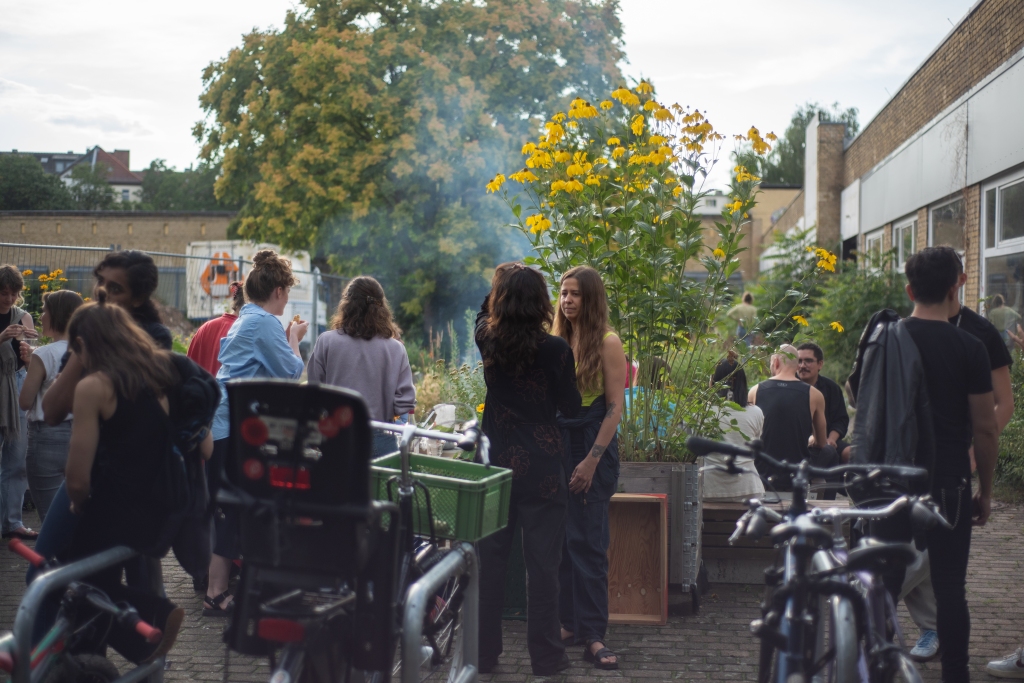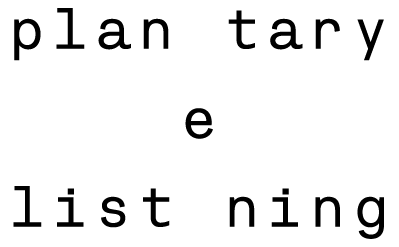Interview with artist-facilitator
Ela Spalding

Ela Spalding (Panama, 1982) is an artist~facilitator exploring the space of art as an elegant conduit to practice and convey expanded notions of ecology and interconnectedness. Her professional background is in film, photography, dance and somatic awareness practices with a keen interest in sound, wellbeing and nature’s processes.
planetary
One of the key areas of focus for the Swamps and Stars series, is the question of listening and its relation to the more-than-human. Could you say something about this – how does this feature in your own practice and research?
ela
For me, listening to the more-than-human is essential in this day and age. My practice involves deep listening as well as empathic listening. Coming from dance and somatics, I like to encourage listening with the whole body, not just the ears. I perceive listening as the basis of good communication, which is in turn the basis for good relationships. As relating better with ourselves, others and nature is the core of my practice and life path, I feel very attuned to the proposal of the Swamps and Stars series.
planetary
The workshop you presented at the Swamps and Stars event in July 2023 made reference to the Suelomethodology, which is aimed at finding ways to reconnect to places in all their depth and complexity. Could you say something about Suelo, and what led you to this methodology – how does this shape your practice?
ela
Suelo was the pilot project to launch my art and ecology platform, Estudio Nuboso, in 2014. It was intended to articulate the natural and cultural value of vulnerable rural places in Panama. I was interested in the geological history, to expand notions of time beyond human existence, and also address land and real estate issues, food security, and practices grounded in local culture and resources. The common thread of all these issues is soil – ground – land. So I called it the Soil Project. After the long covid-19 lockdown, it became clear to me that this format could be of value for people in different contexts around the world, as a way to help us to reconnect with our surroundings and communities. So I started working on writing it out as a methodology. I’m still in the midst of it, piloting various ways of applying it – from individuals, to cultural venues, to educational contexts, and as short workshops such as the Suelo Field Session I offered for Swamps and Stars.
Since I have seen Suelo, and other formats such as the Art and Science LAB or the Flash LAB, as programs or forms of facilitation that I designed and offered through Estudio Nuboso, it is only in the last year or two that I am starting to consciously see the threads of how Suelo is naturally entangled in the shape of my artistic practice as well: identifying cultural features of places and activating experiences through them – with my Calypso jukebox artwork Songs for Limón, Songs for Colón (2016), or addressing the past, present and future of selected locations, while inviting audiences to rest in handmade, traditional fishermen hammocks to the sound of improvised, humming, lullabies for humanity in my installation Ocaso (Sundown), 2019-ongoing. I suppose that is why I call myself an artist~facilitator. As I see my practice of facilitation as an art and art as facilitation.
planetary
This second event in the Swamps and Stars series focused on the theme of “feral landscapes”, and was situated at the Rauthausblock – Dragonerareal site in Kreuzberg, which consists of an assemblage of historical and more recent buildings, along with various derelict zones. How did you relate or respond to this site – were there any particular feral qualities you felt concerned with?
ela
Well, I find this place to be quite confusing. Even after a few visits and conversations with folks deeply involved there, it still remains unclear to me exactly how it works or how the decisions are to be made about the future of this contested urban space, where so many divergent interests coexist. I suppose that makes it feral: being a free, elusive, unexpected space within an urban context where everything else seems to be quite defined by laws, policies, business models, urban planning, and what in Spanish is called “usos de suelo” – land uses in English, I guess. What most attracts me about it is what caught me about Berlin when I moved here 15 years ago – the transitional aspect of urban spaces without a clear authority overlooking them, allowing for people to come in and give it new uses and meanings in all sorts of creative ways.
My way in, following the methodology, was to connect with local inhabitants or users (the holders of knowledge) and invite them to share experiences about different aspects of the place. I connected with the Buendnis fuer Feuer und Flamme – specifically Yann Colonna and Paula Erstmann – who have a couple of participatory practices in a shared workshop/ceramics/creative studio in the back of the Dragonerareal. Both of them are part of a communal Keramiktreff every Tuesday afternoon, open to the public. Paula also is an amazing cook, engaging with whatever grows and is edible around the place she cooks. She and I had met a year ago in a seminar called Towards Permacultural Institutions in Schöppingen, so the collaboration flowed very well. Yann, I just met a couple of times, but his urban research resonated with me immediately, as he is seeking to “make history” with earth and fire, by creating ceramic tiles with impressions from textures and surfaces of the Rathausblock. This was an important part of the Suelo Field Session. Yann couldn’t be there, so he gave me the instructions to invite participants to make their own impressions and be part of the capturing of history or memory of this place for posterity.
Although it was a tough location to work in initially, it was one of my favourite Suelo Field Sessions so far. We started with the Suelo, here and now, a guided meditation I created for the methodology. Then I read a story by Ian Warner called Glacial Berlin, that was in my installation of Sundown in Humboldthain Park in 2021. This story provides a little time travel to Berlin in the ice ages and the swamps it then became prior to human settlement. Then I invited participants to walk in silence, listening with all their senses to the space and its multiple histories and temporalities. I guided us towards the ceramic workshop, where I introduced Yann’s simple yet powerful exercise with clay. After a short but strong rain shower, we walked back to the Kiezraum where we had started around a fire which was luckily still burning. Paula then invited us to knead some dough, and we shared delicious flatbread, with seasonal beets and peaches fired in salty dough, as well as dips made partly with gathered herbs from the raised beds that a group of women care for on site.
The result was a warm gathering that got more and more familial. Folks felt moved in various ways and were inclined to stick around, chat and exchange well beyond the two hours of the workshop. I find that Suelo has that power – to combine themes and things that seem disconnected and complex, but that are ultimately interconnected (as is everything), and offer a space for people to engage with and share that entanglement in light and deep ways. Thank you for the invitation!
To read a bit more about the Suelo Methodology, visit https://estudionuboso.org/en/suelo/
